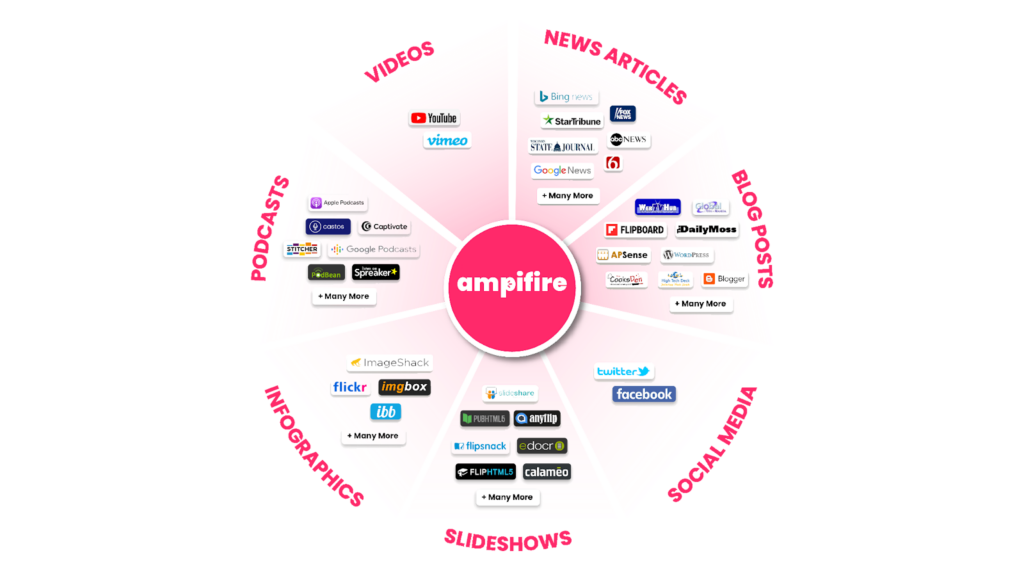Key Takeaways
- PR crisis management is a strategic process that prepares, responds to, and recovers from events that could harm a company’s reputation, operations, or financial stability.
- Businesses face four primary types of crises: operational, financial, personnel, and technological, and each requires unique response strategies.
- Effective crisis management protects the company’s reputation, preserves stakeholder trust, prevents financial losses, and strengthens team unity.
- Historical case studies, such as the Tylenol crisis at Johnson & Johnson, illustrate how effective crisis management can turn potential disasters into opportunities to build trust.
- AmpiFire helps companies move beyond traditional PR by creating multi-format content across various platforms so that your crisis messaging reaches audiences wherever they consume information.
Understanding Crisis Management
PR crisis management is the methodical approach companies use to address severe threats to their reputation, stakeholders, and business operations. It includes the strategies, procedures, and actions taken before, during, and after a crisis event to reduce damage and restore normalcy.
Unlike typical PR challenges, crises escalate quickly, draw significant attention, and can permanently change public perception if not handled correctly.
Proactive crisis management is what separates the good from the great. Companies that excel at managing crises routinely assess their vulnerabilities, train their spokespersons, conduct crisis drills, and build solid relationships with the media during times of peace.
This groundwork is worth its weight in gold when unexpected issues arise that could otherwise take an unprepared company to its knees.
Why Press Releases Don’t Work Anymore
Smart Businesses Are Moving Beyond Traditional PR
• The Problem: Press releases reach one audience through one channel while your customers are everywhere online. Most get buried within days with poor ROI.
• The Solution: AmpiFire’s AmpCast creates 8 different content formats from one topic and distributes across 300+ high-authority sites including Fox affiliates, Spotify, and YouTube.
What You’ll Learn on PR Zen:
✓ Why multi-channel content delivers 10x better results than press releases
✓ How to amplify your PR efforts across multiple platforms
✓ Real case studies of businesses dominating search, social, video, and podcasts
✓ Cost-effective alternative to expensive PR agencies
Ready to Replace Press Releases? Learn the AmpiFire Method →
Categories of Crisis Management
Recognizing the various kinds of crises that might impact your company is key to creating thorough response plans:
Operational Disasters

Operational disasters are interruptions in a company’s core business activities that often affect product distribution, service standards, or supply chain reliability.
These circumstances usually arise from incidents such as natural catastrophes, equipment malfunctions, significant accidents, or supply chain disruptions that halt regular business functions.
To manage them effectively, organizations need to be transparent about the situation, clearly communicate the steps they are taking to address the problem, and demonstrate genuine concern for the affected stakeholders.
Monetary Crises
Monetary crises arise when companies grapple with significant financial difficulties that could jeopardize their stability and survival. These can be triggered by market declines, fraud allegations, accounting inconsistencies, unforeseen losses, or investor concerns.
When dealing with a financial crisis, it’s essential to communicate openly and honestly, while remaining mindful of the law. You’ll also want to restore investor confidence by maintaining a consistent message, demonstrating that steps are being taken to address the problem, and, when necessary, making significant changes in the company’s leadership.
Staffing Crises
Staffing crises involve employee actions, leadership missteps, or workplace incidents that put an organization’s values and culture at risk. These situations can include executive controversies, discrimination, workplace bullying, or employee behavior that breaches company rules or societal norms.
Crisis communication in these situations must address valid concerns, detail the steps being taken to correct the issue, and often show a commitment to making cultural or structural changes to prevent the same problem from happening again.
Crises in Technology
Technology crises include system breakdowns, cybersecurity breaches, violations of data privacy, or any other incidents related to technology that could compromise a business’s operations or customers’ information.
These crises can severely erode customer trust and result in regulatory penalties. Businesses need to rapidly determine the extent of the issue, limit the harm, and provide affected stakeholders with information they can use.
The Positive Impact of Crisis Management in Your Office
Strong crisis management does much more than just help a company get through challenging times. Here are some ways that solid crisis management can improve a company’s health and longevity.
Safeguarding Your Reputation
When a crisis hits, years of hard-earned reputation can be destroyed in hours. Good crisis management is about protecting that reputation and showing that your company’s values are actions you live by.
When companies respond to a crisis with transparency, accountability, and empathy, they can turn a potential reputation-destroying event into an opportunity to strengthen their reputation.
Building Trust with Stakeholders

How a company responds to a crisis can make or break the trust they have with its stakeholders. This includes their customers, employees, investors, regulators, and even the community they serve.
When a company effectively handles a crisis, it shows that it is committed to the welfare of its stakeholders, not just its bottom line. This can actually strengthen the bond between the company and its stakeholders, creating a level of loyalty that may not have existed before the crisis.
Safeguarding Financial Health
Effective crisis management protects an organization’s reputation and its financial health. The savings come from several areas: reduced litigation risk, faster operational recovery, less disruption to revenue, and lower customer churn.
Companies with strong crisis management capabilities tend to experience less severe stock price impacts and recover their market value more quickly after adverse events.
Team Bonding
Crises are the ultimate test of an organization’s culture and leadership. Teams that weather storms together often come out stronger, with more trust in each other and a better understanding of their shared values.
Good crisis management provides a roadmap through the chaos, so employees can focus on finding solutions instead of being paralyzed by uncertainty.
Good Crisis Management Examples
By examining cases where crisis management was successful, we can better understand what makes a response strategy effective. These real-world examples show how some organizations turned what could have been disasters into opportunities.
The Tylenol Case with Johnson & Johnson
In 1982, Johnson & Johnson faced a crisis that could have ended its business. Seven people died in Chicago after consuming Tylenol capsules laced with cyanide. Johnson & Johnson’s response to the situation is now one of the most studied examples of effective crisis management.
Instead of trying to minimize the situation or shift the blame, Johnson & Johnson took immediate, decisive action. They recalled 31 million bottles of Tylenol, valued at $100 million. This was a move that had never been done before.
What’s most impressive is that Johnson & Johnson turned the crisis into a chance for innovation by introducing tamper-evident packaging that changed the game in pharmaceutical safety standards. Their approach led them to recover their market share and gain more trust among their customers.
Southwest Airlines Response to Disaster

In 2018, Southwest Airlines faced an engine failure that led to the death of a passenger, showing how to manage a crisis in the digital age. When a passenger on Flight 1380 died due to a catastrophic engine failure, Southwest had to deal with both an operational emergency and a significant communications challenge.
Southwest Airlines halted all promotional advertising and social media content, replacing them with emergency information and support resources. They created dedicated communication channels for the families of passengers and worked closely with the National Transportation Safety Board to ensure that all public statements were accurate. The airline’s transparent approach included regular updates on its investigation and safety review processes.
Southwest’s response to this tragedy is a textbook example of effective crisis management. They immediately acknowledged the incident, communicated with compassion, shared information transparently, and engaged leadership visibly.
Shift from Conventional PR with AmpiFire

How AmpiFire Works
In the face of a crisis, a single-channel communication plan is no longer enough—you need to be present wherever your audience is. AmpiFire converts your message into eight different content types: news articles, blog posts, infographics, slideshows, podcasts, long-form videos, social posts, and short-form videos. This all-inclusive approach ensures your message reaches audiences on their favorite platforms.
The AmpCast AI technology is responsible for content distribution across more than 300 platforms such as Google News, YouTube, Spotify, Pinterest, Fox affiliate sites, and MSN. Instead of simply hoping journalists will pick up your press release, AmpiFire ensures your carefully crafted messaging reaches audiences directly through platforms they already trust and use daily.
Real Results from Multi-Channel Content
One AmpiFire client in the medical device space saw their eCommerce traffic increase by 300% using AmpiFire’s platform, which generated an initial 51% increase in sales. This was the result of one specific case study and reflects consistent content creation over time.
Results vary by industry, competition, and how consistently you publish content, but it goes to show the effectiveness of multi-content and multi-platform distribution. Companies that maintain an ongoing content strategy through AmpiFire are also better positioned to respond effectively during crises, as they already have an established presence across multiple channels.
This method delivers a significantly higher return on investment than conventional PR or in-house content teams because we diversify content creation and distribution, reaching potential customers across multiple channels simultaneously. In crises, this means your response is not limited to a single press statement but becomes a coordinated campaign that builds credibility across platforms while effectively managing the narrative.
Frequently Asked Questions (FAQs)
What is the ideal response time for a company in a PR crisis?
When a PR crisis strikes, the first 24–48 hours are the most crucial, with the optimal response time within the first hour, often called the “golden hour” of crisis communication.
While it may not be possible to provide all the facts immediately, it’s essential to issue a statement acknowledging the situation as soon as possible to show that you’re aware of it and addressing it.
What are the components of a crisis management plan?
Each crisis management plan should clearly outline the roles and responsibilities of the crisis team, including primary and backup assignments for each role. Ensure that the contact information for important internal and external stakeholders is kept up to date.
Measures for maintaining core business functions during disruptions should also be included in the plan. Include schedules for regular testing and explain how the organization will assess the effectiveness of the crisis response and make changes to improve future readiness.
Is social media beneficial in a PR crisis?
Social media can be a blessing and a curse during a crisis. It can spread bad news like wildfire, but it also gives businesses a direct line to their stakeholders. If used correctly, social media enables real-time monitoring of public opinion, direct engagement with concerned stakeholders, and rapid dissemination of official information.
Businesses should have a social media crisis plan that includes more frequent monitoring, a process for approving crisis-related posts, and rules for interacting with public comments and questions.
How can you gauge the effectiveness of crisis management?
Quantitative measurements include analytics on response times (how quickly the organization acknowledged the crisis and provided information), metrics on media coverage (volume, sentiment, message penetration), statistics on social media engagement (reach, sentiment, sharing patterns), and indicators of financial impact (fluctuations in stock price, impacts on sales, litigation costs).
How can AmpiFire help with crisis management?
AmpiFire helps with crisis management by transforming your response message into eight different content formats (news articles, blog posts, infographics, slideshows, podcasts, long-form videos, social posts, and short-form videos) and distributing them across 300+ platforms, including Google News, YouTube, Spotify, Pinterest, Fox affiliate sites, and MSN.
This multi-channel approach ensures your crisis messaging reaches audiences directly on platforms they trust.

